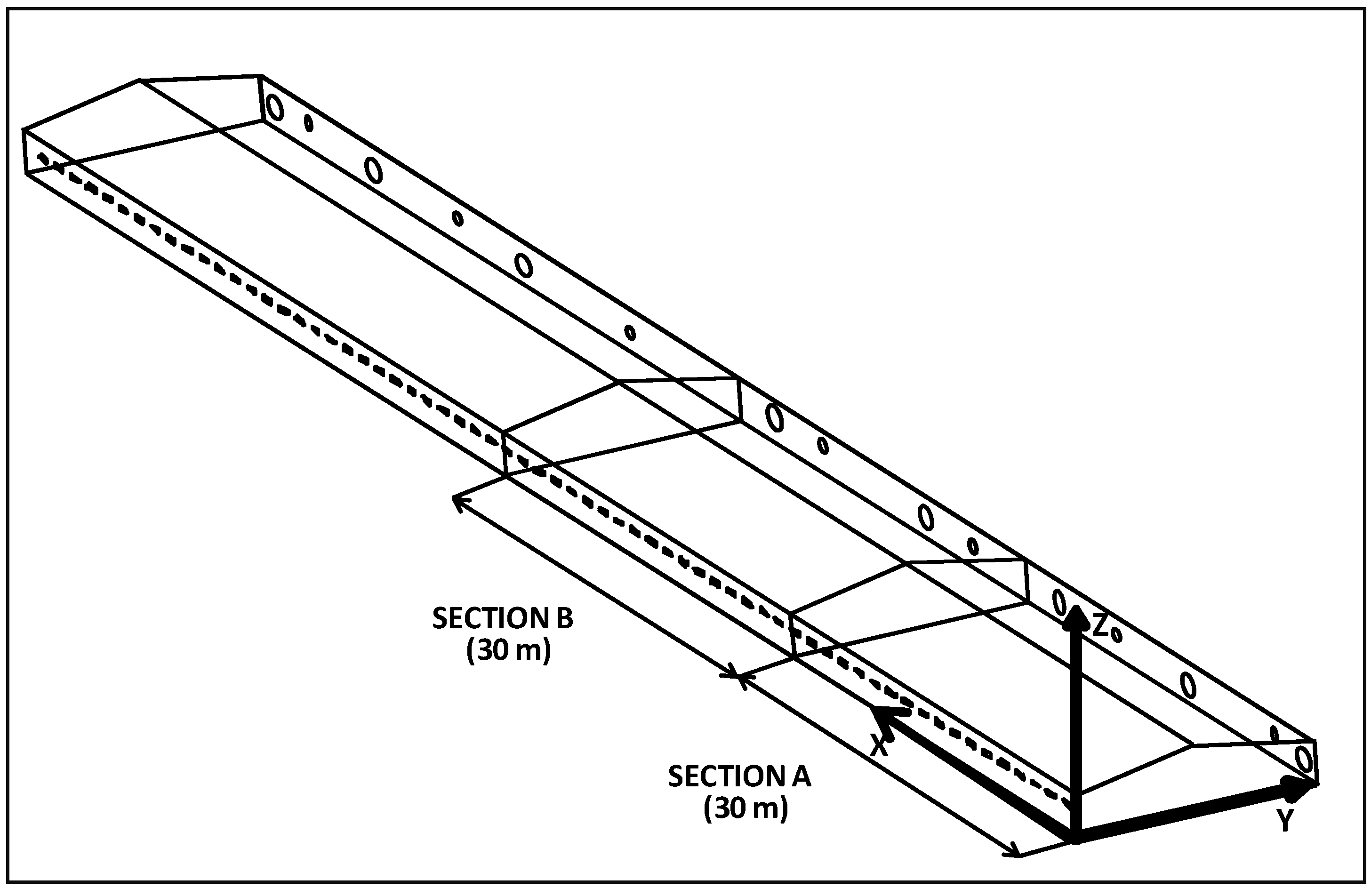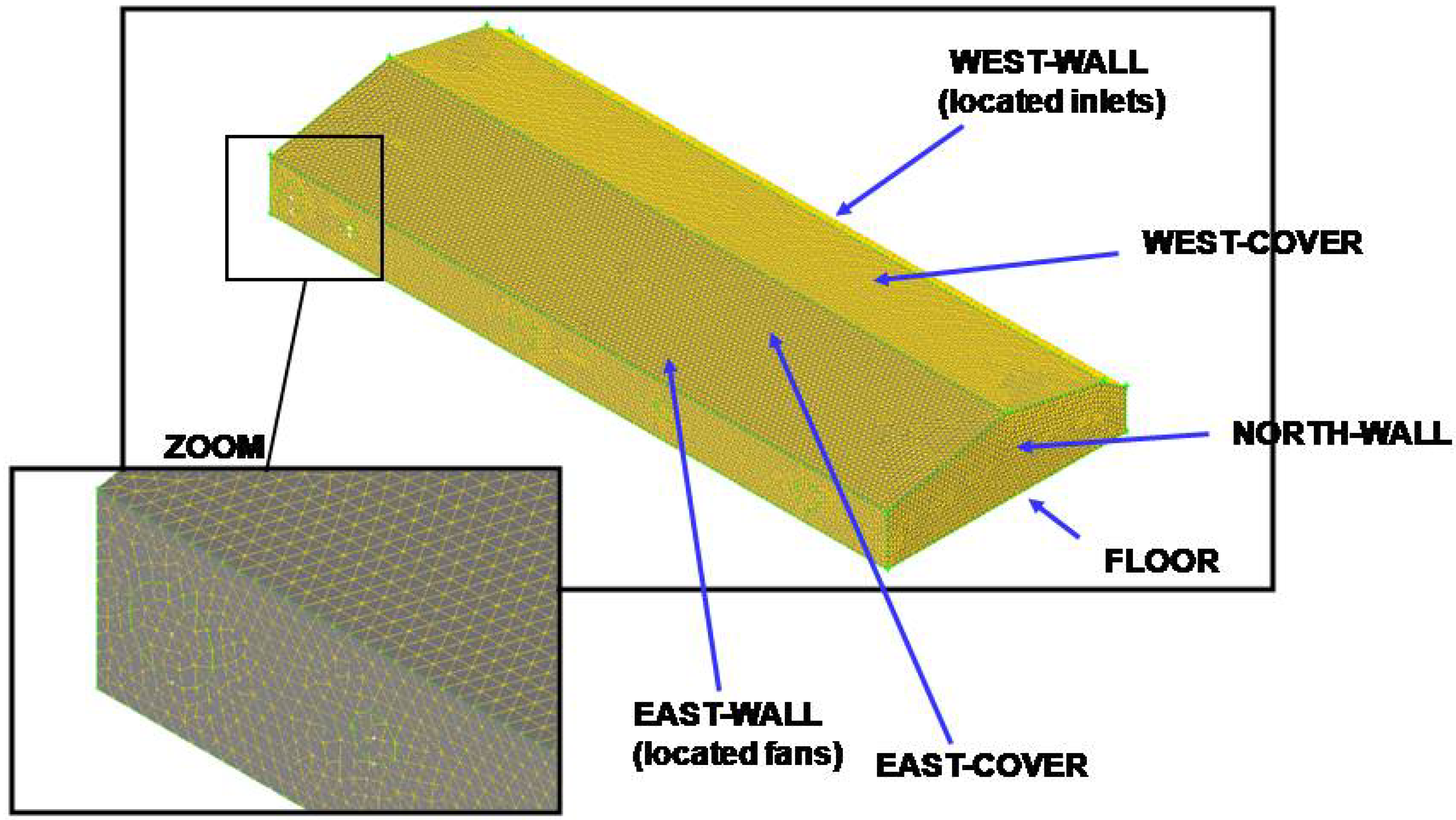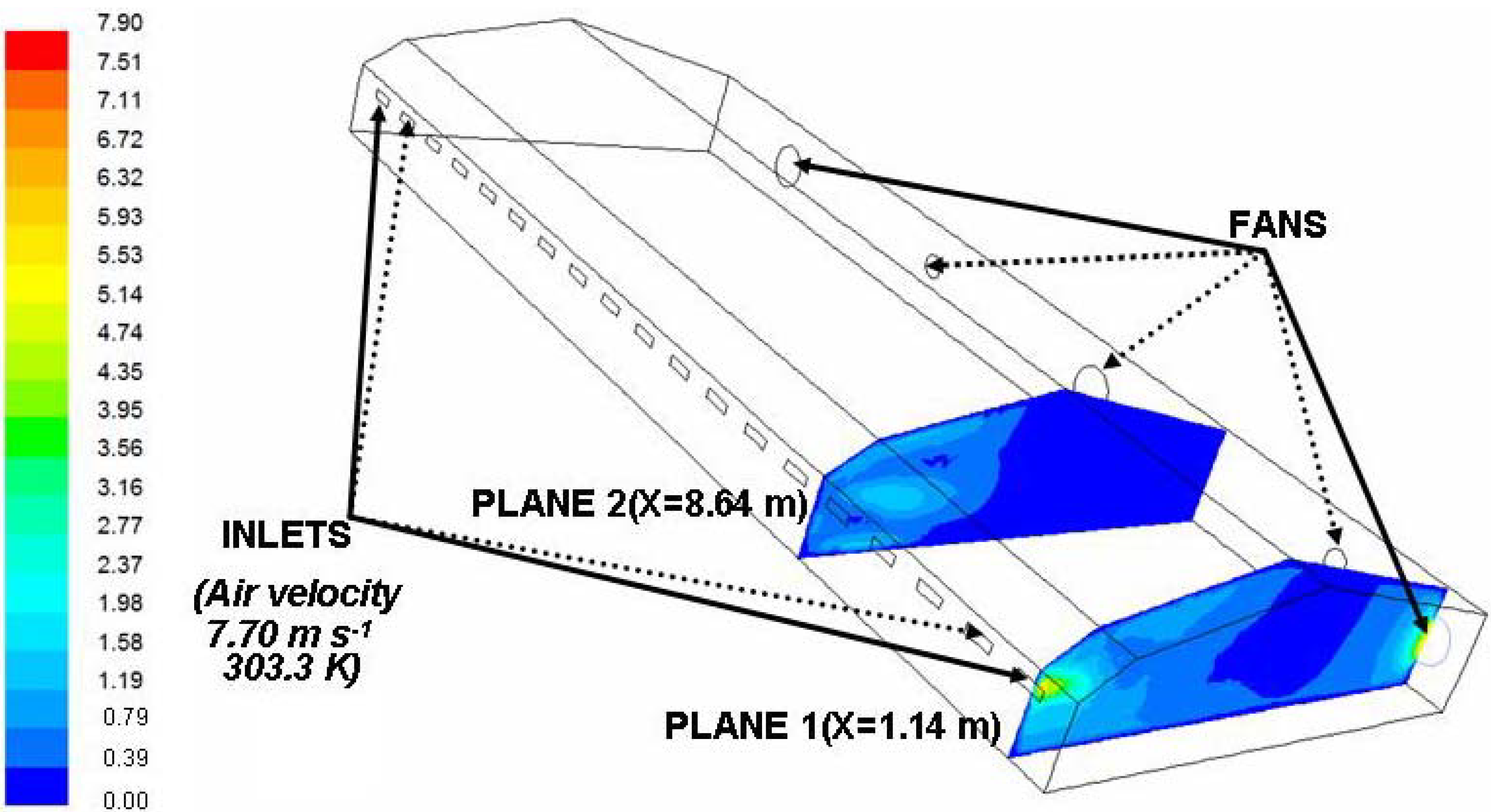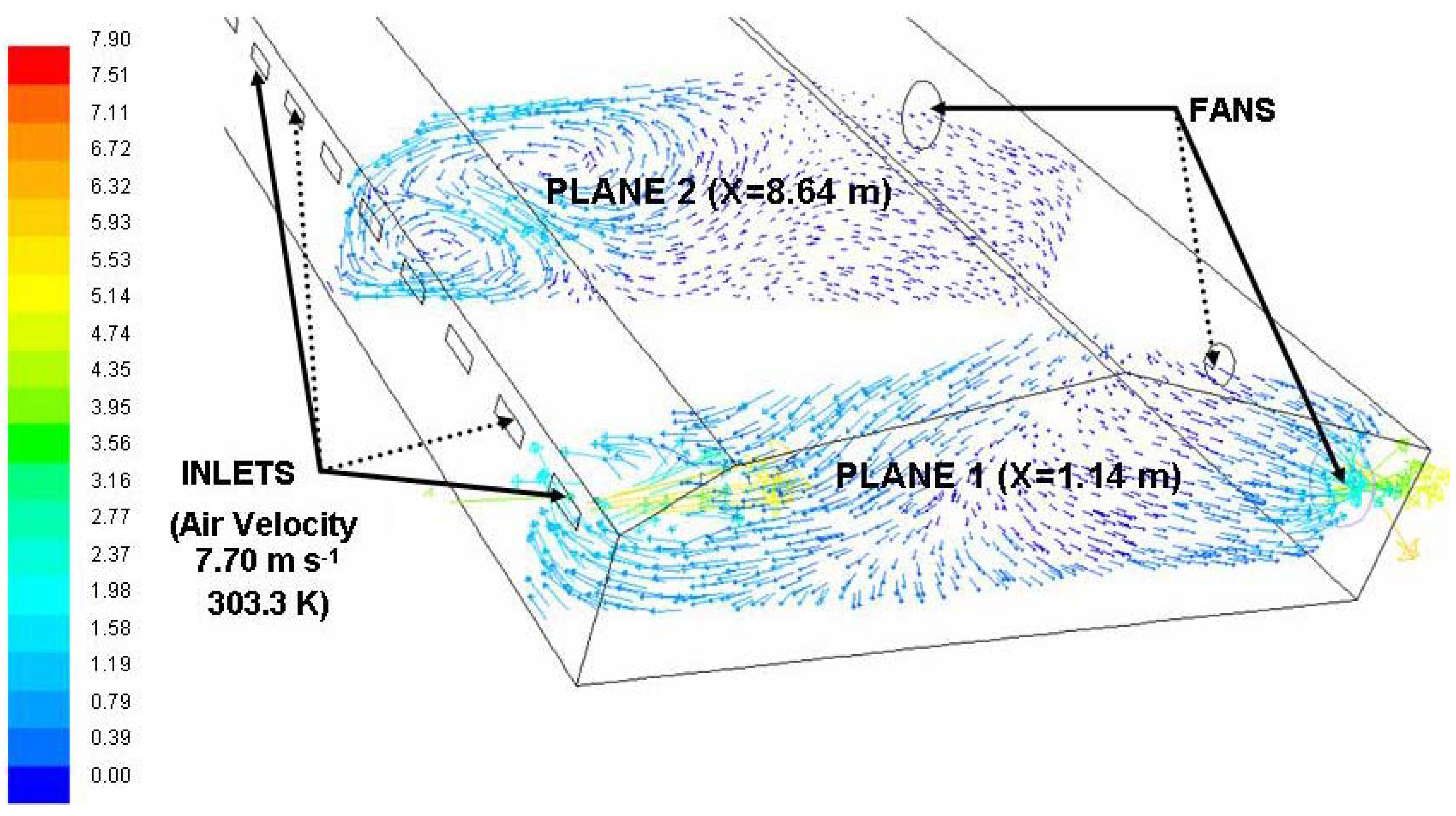Exploring Ventilation Efficiency in Poultry Buildings: The Validation of Computational Fluid Dynamics (CFD) in a Cross-Mechanically Ventilated Broiler Farm
Abstract
:1. Introduction
2. Materials and Methods
2.1. Experimental Poultry Farm
2.2. Test Sections and Multisensor System for Direct Measurements

| Sensor number * | Section A | Section B | ||
|---|---|---|---|---|
| X-coordinate (m) | Y-coordinate (m) | X-coordinate (m) | Y-coordinate (m) | |
| 1–2 | 22.45 | 0.30 | 35.90 | 0.05 |
| 3–4 | 19.50 | 12.00 | 31.50 | 11.80 |
| 5–6 | 18.00 | 11.95 | 32.80 | 11.95 |
| 7–8 | 9.30 | 12.00 | 41.80 | 7.15 |
| 9–10 | 5.70 | 12.05 | 40.70 | 6.80 |
| 11–12 | 0.60 | 12.00 | 45.85 | 11.35 |
| 13–14 | 0.55 | 6.30 | 47.35 | 4.50 |
| 15–16 | 0.50 | 7.60 | 46.95 | 5.35 |
| 17–18 | 0.55 | 2.15 | 44.05 | 0.80 |
| 19–20 | 8.70 | 6.70 | 48.50 | 3.15 |
| 21–22 | 24.85 | 7.10 | 47.70 | 1.10 |
| 23–24 | 23.60 | 7.15 | 47.70 | 0.65 |
2.3. CFD Background



2.4. Turbulence Models and Boundary Conditions (BC)



| (i) Constant and computational settings | |||||
| 3D double precision Segregated Steady Turbulence model: Standard k-ε Wall treatment: Standard Wall Functions Pressure-velocity coupling: SIMPLE algorithm Discretization scheme: Pressure: standard; Momentum: Second order upwind; Turbulence kinetic energy: Second order upwind; Turbulence dissipation rate: Second order upwind; Energy: Second order upwind. Air properties: Density: 1.225 Kg m−3; Cp: 1006.43 J kg−1 K−1; Thermal conductivity: 0.0242 W m−1 K−1; Viscosity: 1.789·10−5 kg m−1s−1. Wall material: Density: 2400 Kg m−3; Cp= 1125 J kg−1 K−1; Thermal conductivity: 1.2 W m−1 K−1. Atmospheric pressure: 101,325 Pa. Gravitational acceleration: 9.81 m s−2. | |||||
| (ii) Boundary Conditions | |||||
| CFD Simulation | Assay Section | Scenario | Outlets (Fans) Mass Flux rate at each outlet (in kg s−1) Air temperature at each outlet (in K) | Inlet Air (10% Turbulence Intensity (1)) Air velocity (in m s−1) Air temperature (in K) | Temperature at solid elements (in K) Floor North-Wall (2) South-Wall (2) East-Wall (2) West-Wall (2) East-Cover (2) West-Cover (2) |
| I | Section A | I | Large = 9.60 Kg s−1 303.7 K Small = 0 | 6.62 m s−1 304.5 K | 303.0 K 303.4 K 304.7 K 305.1 K 304.1 K 305.5 K 305.0 K |
| II | Section A | II | Large = 9.03 Kg s−1 301.9 K Small = 3.2 Kg s−1 301.9 K | 7.70 m s−1 303.3 K | 303.0 K 302.5 K 303.0 K 303.5 K 302.0 K 303.5 K 302.0 K |
| III | Section A | III | Large = 8.17 Kg s−1 303.7 K Small = 0 | 9.01 m s−1 304.5 K | 302.0 K 303.4 K 304.6 K 306.6 K 303.1 K 305.7 K 305.0 K |
| IV | Section A | IV | Large = 7.82 Kg s−1 301.9 K Small = 2.78 Kg s−1 301.9 K | 10.67 m s−1 303 K | 303.0 K 302.5 K 303.0 K 304.0 K 302.0 K 303.5 K 302.0 K |
| V | Section B | I | Large = 9.60 Kg s−1 304.8 K Small = 0 | 4.66 m s−1 305.6 K | 305.0 K 305.0 K 306.0 K 307.0 K 303.0 K 305.0 K 304.0 K |
| (ii) Boundary Conditions | |||||
| VI | Section B | II | Large = 9.03 Kg s−1 305.1 K Small = 3.2 Kg s−1 305.1 K | 5.93 m s−1 305.8 K | 304.0 K 304.0 K 306.0 K 307.3 K 303.5 K 305.7 K 304.6 K |
| VII | Section B | III | Large = 8.17 Kg s−1 304.9 K Small = 0 | 6.35 m s−1 305.8 K | 304.0 K 304.5 K 306.0 K 307.2 K 303.2 K 305.5 K 304.3 K |
| VIII | Section B | IV | Large = 7.89 Kg s−1 305.1 K Small = 2.78 Kg s−1 305.1 K | 8.23 m s−1 306.2 K | 304.0 K 304.0 K 306.0 K 307.5 K 303.5 K 305.3 K 304.7 K |

2.5. Statistical Validation Model

- Yijk: Air velocity in the section i at boundary conditions j at height k by the sensor l and by methodology n;
- Zi: Measurement section (2);
- Bj: Boundary conditions (4);
- Hk: Height of the sensor (2);
- SNl: Sensor l (24);
- Mn: Methodology: CFD vs. direct measurements using the multisensor system (2);
- (Z X B)ij: Interaction between Section-Boundary (8);
- (Z X H)ik: Interaction between Section-Height (4);
- (Z X M)in: Interaction between Section-Methodology (4);
- (Z X SN)il: Interaction between Section-Sensor (48);
- (B X H)jk: Interaction between Boundary-Height (8);
- (B X SN)jl: Interaction between Boundary-Sensor (96);
- (B X M)jn: Interaction between Boundary-Methodology (8);
- (H X M)lk: Interaction between Height-Methodology (4);
- (SN X H)lk: Interaction between Sensor-Height (48);
- (Z X B X H)ijk: Triple interaction between Section-Boundary-Height (16);
- (Z X SN X M)iln: Triple interaction between Section-Sensor-Methodology (96);
- (B X SN X M)jln: Triple interaction between Boundary-Sensor-Methodology (192);
- (Z X B X H X M)ijkn: Four interaction between Section-Boundary-Height-Methodology (384);
- εijkln: Error of the model
3. Results and Discussion
3.1. CFD vs. Direct Measurements
| Scenario | Height | Methodology | Section A | Section B | Mean |
|---|---|---|---|---|---|
| I | 0.25 m | Measured | 0.62 ± 0.86 (12) | 0.37 ± 0.30 (12) | 0.50 ± 0.65 (24) |
| CFD | 0.52 ± 0.68 (12) | 0.34 ± 0.29 (12) | 0.43 ± 0.52 (24) | ||
| 1.75 m | Measured | 0.37 ± 0.39 (12) | 0.66 ± 1.00 (12) | 0.52 ± 0.76 (24) | |
| CFD | 0.35 ± 0.40 (12) | 0.62 ± 0.97 (12) | 0.49 ± 0.74 (24) | ||
| Mean | Measured | 0.50 ± 0.67 (24) | 0.53 ± 0.74 (24) | 0.51 ± 0.70 (48) | |
| CFD | 0.43 ± 0.55 (24) | 0.48 ± 0.71 (24) | 0.46 ± 0.63 (48) | ||
| II | 0.25 m | Measured | 0.70 ± 0.35 (12) | 0.71 ± 0.29 (12) | 0.71 ± 0.33 (24) |
| CFD | 0.60 ± 0.30 (12) | 0.74 ± 0.36 (12) | 0.67 ± 0.33 (24) | ||
| 1.75 | Measured | 0.47 ± 0.32 (12) | 0.68 ± 0.47 (12) | 0.58 ± 0.41 (24) | |
| CFD | 0.41 ± 0.34 (12) | 0.68 ± 0.50 (12) | 0.55 ± 0.44 (24) | ||
| Mean | Measured | 0.59 ± 0.35 (24) | 0.70 ± 0.38 (24) | 0.64 ± 0.37 (48) | |
| CFD | 0.60 ± 0.30 (24) | 0.71 ± 0.43 (24) | 0.61 ± 0.39 (48) | ||
| III | 0.25 m | Measured | 0.78 ± 0.41 (12) | 0.80 ± 0.31 (12) | 0.79 ± 0.35 (24) |
| CFD | 0.73 ± 0.36 (12) | 0.89 ± 0.43 (12) | 0.75 ± 0.36 (24) | ||
| 1.75 m | Measured | 0.63 ± 0.34 (12) | 0.77 ± 0.50 (12) | 0.70 ± 0.42 (24) | |
| CFD | 0.50 ± 0.32 (12) | 0.79 ± 0.55 (12) | 0.65 ± 0.47 (24) | ||
| Mean | Measured | 0.71 ± 0.37 (24) | 0.79 ± 0.41 (24) | 0.75 ± 0.39 (48) | |
| CFD | 0.62 ± 0.35 (24) | 0.84 ± 0.49 (24) | 0.73 ± 0.44 (48) | ||
| IV | 0.25 m | Measured | 0.42 ± 0.26 (12) | 0.65 ± 0.59 (12) | 0.54 ± 0.46 (24) |
| CFD | 0.37 ± 0.27 (12) | 0.54 ± 0.38 (12) | 0.46 ± 0.34 (24) | ||
| 1.75 m | Measured | 0.72 ± 0.69 (12) | 0.77 ± 0.87 (12) | 0.74 ± 0.75 (24) | |
| CFD | 0.72 ± 0.87 (12) | 0.80 ± 1.04 (12) | 0.76 ± 0.94 (24) | ||
| Mean | Measured | 0.57 ± 0.53 (24) | 0.71 ± 0.71 (24) | 0.64 ± 0.62 (48) | |
| CFD | 0.54 ± 0.65 (24) | 0.67 ± 0.78 (24) | 0.61 ± 0.71(48) | ||
| All | 0.25 m | Measured | 0.63 ± 0.53 (48) | 0.63 ± 0.41 (48) | 0.63 ± 0.47 (96) |
| CFD | 0.55 ± 0.44 (48) | 0.63 ± 0.41 (48) | 0.59 ± 0.43 (96) | ||
| 1.75 m | Measured | 0.55 ± 0.47 (48) | 0.72 ± 0.71 (48) | 0.63 ± 0.61 (96) | |
| CFD | 0.50 ± 0.53 (48) | 0.72 ± 0.78 (48) | 0.61 ± 0.67 (96) | ||
| Mean | Measured | 0.59 ± 0.50 (96) | 0.68 ± 0.58 (96) | 0.63 ± 0.54 (192) | |
| CFD | 0.52 ± 0.49 (96) | 0.68 ± 0.62 (96) | 0.60 ± 0.56 (192) |
3.2. CFD-Air Velocity Results


3.3. Results of the Validation Model
| Parameter | DF | Sum of squares | Mean square | F-ratio | p-value |
|---|---|---|---|---|---|
| Section | 1 | 1.31 | 1.32 | 2.94 | 0.4895 |
| Boundary | 3 | 3.16 | 1.05 | 1.87 | 0.4551 |
| Height | 1 | 0.01 | 0.01 | 0.02 | 0.9184 |
| Sensor | 22 | 34.83 | 1.58 | 0.89 | 0.6041 |
| Methodology | 1 | 0.11 | 0.11 | 0.46 | 0.5271 |
| Section × Boundary | 3 | 0.24 | 0.08 | 0.20 | 0.8884 |
| Section × Height | 1 | 0.59 | 0.59 | 0.36 | 0.5574 |
| Section × Methodology | 1 | 0.11 | 0.11 | –1.92 | - |
| Section × Sensor | 22 | 30.31 | 1.38 | 51.55 | <0.0001 |
| Boundary × Height | 3 | 2.41 | 0.80 | 1.15 | 0.3829 |
| Boundary × Sensor | 66 | 26.77 | 0.40 | 33.98 | <0.0001 |
| Boundary × Methodology | 3 | 0.01 | 0.003 | –0.05 | - |
| Height × Methodology | 1 | 0.01 | 0.01 | –0.07 | - |
| Sensor × Height | 22 | 0.66 | 0.03 | –0.47 | - |
| Section × Boundary × Height | 3 | 1.20 | 0.40 | 22.12 | 0.0012 |
| Section × Sensor × Methodology | 22 | 0.59 | 0.03 | 0.26 | 0.9997 |
| Boundary × Sensor × Methodology | 66 | 0.79 | 0.01 | 0.12 | 1.0000 |
| Section × Boundary × Height × Methodology | 6 | 0.11 | 0.02 | 0.17 | 0.9833 |
| Error | 132 | 13.68 | 0.10 | - | - |

4. Conclusions
Acknowledgments
Conflict of Interest
References
- Charles, D.; Walker, A. Poultry Environment Problems: A Guide to Solutions, 1st ed.; Charles, D., Walker, A., Eds.; Nottingham University Press: Nottingham, UK, 2002. [Google Scholar]
- MWPS (Midwest Plan Service). Mechanical Ventilating Systems for Livestock Housing, 1st ed.; Midwest Plan Service, Iowa State University: Ames, IA, USA, 1990. [Google Scholar]
- Medio millón de pollos mueren por el fuerte calor de los últimos días. Available online: http://elpais.com/diario/2003/06/17/cvalenciana/1055877480_850215.html (accessed on 14 November 2012).
- Korea heat wave kills off 830,000 chickens (in August 2012). Available online: http://www.worldpoultry.net/Broilers/Health/2012/8/S-Korean-heat-wave-kills-off-830000-chickens-WP010736W/ (accessed on 7 May 2013).
- Bustamante, E.; Guijarro, E.; García-Diego, F.J.; Balasch, S.; Torres, A.G. Multisensor system for isotemporal measurements to assess indoor climatic conditions in poultry farms. Sensors 2012, 12, 5752–5774. [Google Scholar] [CrossRef] [PubMed]
- Dawkins, M.S.; Donnelly, C.A.; Jones, T.A. Chicken welfare is influenced more by housing conditions than stocking density. Nature 2004, 427, 342–344. [Google Scholar] [CrossRef] [PubMed]
- European Union (EU). Laying down Minimum Rules for the Protection of Chickens Kept for Meat Production; EU Council Directive 2007/43/EC; European Union: Brussels, Belgium, 2007. [Google Scholar]
- Lott, B.D.; Simmons, J.D.; May, J.D. Air velocity and high temperature effects on broiler performance. Poult. Sci. 1998, 77, 391–393. [Google Scholar] [CrossRef] [PubMed]
- May, J.D.; Lott, B.D.; Simmons, J.D. The effect of air velocity on broiler performance and feed and water consumption. Poult. Sci. 2000, 79, 1396–1400. [Google Scholar] [CrossRef] [PubMed]
- Yavah, S.; Straschnow, A.; Vax, E.; Razpakovski, V.; Shinder, D. Air velocity alters broiler performance under harsh environmental conditions. Poult. Sci. 2001, 80, 724–726. [Google Scholar] [CrossRef] [PubMed]
- Yanagi, T.; Xin, H.; Gates, R.S. A research facility for studying poultry responses to heat stress and its relief. Appl. Eng. Agric. 2002, 18, 255–260. [Google Scholar] [CrossRef]
- Simmons, J.D.; Lott, B.D.; Miles, D.M. The effects of high-air velocity on broiler performance. Poult. Sci. 2003, 82, 232–234. [Google Scholar] [CrossRef] [PubMed]
- Yavah, S.; Straschnow, A.; Luger, D.; Shinder, D.; Tanny, J.; Cohen, S. Ventilation, sensible heat loss, broiler energy and water balance under harsh environmental conditions. Poult. Sci. 2004, 83, 253–258. [Google Scholar] [CrossRef] [PubMed]
- Bartzanas, T.; Kittas, C.; Sapounas, A.A.; Nikita-Martzopoulou, C. Analysis of airflow through experimental rural buildings: Sensitivity to turbulence models. Biosyst. Eng. 2007, 97, 229–239. [Google Scholar] [CrossRef]
- Mistriotis, A.; de Jong, T.; Wagemans, M.J.M.; Bot, G.P.A. Computational fluid dynamics as a tool for the analysis of ventilation and indoor microclimate in agriculture buildings. Neth. J. Agr. Sci. 1997, 45, 81–96. [Google Scholar]
- Norton, T.; Sun, D.; Grant, J.; Fallon, R.; Dodd, V. Applications of computational fluid dynamics (CFD) in the modeling and design of ventilation systems in the agricultural industry: A review. Bioresour. Technol. 2007, 98, 2386–2414. [Google Scholar] [CrossRef]
- Norton, T.; Grant, J.; Fallon, R.; Sun, D.-W. Assessing the ventilation effectiveness of naturally ventilated livestock buildings under wind dominated conditions using computational fluid dynamics. Biosyst. Eng. 2009, 103, 78–99. [Google Scholar] [CrossRef]
- Blanes-Vidal, V.; Guijarro, E.; Balasch, S.; Torres, A.G. Application of computational fluid dynamics to the prediction of airflow in a mechanically ventilated commercial poultry building. Biosyst. Eng. 2008, 100, 105–116. [Google Scholar] [CrossRef]
- Lee, I.B.; Sase, S.; Sung, S.H. Evaluation of CFD accuracy for the ventilation study of a naturally ventilated broiler house. Jpn. Agric. Res. Q. 2007, 41, 53–64. [Google Scholar] [CrossRef]
- Pawar, S.R.; Cimbala, J.M.; Wheeler, E.F.; Lindberg, D.V. Analysis of poultry house ventilation using computational fluid dynamics. Trans. ASABE 2007, 50, 1373–1382. [Google Scholar] [CrossRef]
- Oberkampf, W.L.; Trucano, T.G. Verification and validation in computational fluid dynamics. Progr. Aerosp. Sci. 2002, 38, 209–272. [Google Scholar] [CrossRef]
- Fluent User’s Guide, version 6.0; Fluent Inc.: Lebanon, NH, USA, 2001.
- Wheeler, E.F.; Zajaczkowski, J.L.; Saheb, N.C. Field evaluation of temperature and velocity uniformity in tunnel and conventional ventilation broiler houses. Appl. Eng. Agric. 2003, 19, 367–377. [Google Scholar]
- Gambit User’s Guide, version 2.0; Fluent Inc.: Lebanon, NH, USA, 2001.
- Patankar, S.V. Numerical Heat Transfer and Fluid Flow; Hemisphere Publishing Corporation: Washington, WA, USA, 1980. [Google Scholar]
- Launder, B.E.; Spalding, D.B. The numerical computation of turbulent flows. Comput. Method. Appl. M. 1974, 3, 269–289. [Google Scholar] [CrossRef]
- Calvet, S.; Cambra-López, M.; Blanes-Vidal, V.; Estellés, F.; Torres, A.G. Ventilation rates in mechanically ventilated commercial poultry buildings in Southern Europe: Measurement system development and uncertainty analysis. Biosyst. Eng. 2010, 106, 423–432. [Google Scholar] [CrossRef]
- Testo Inc. Homepage. Available online: http://www.testo.com (accessed on 19 March 2013).
- Bjerg, B.; Svidt, K.; Zhang, G.; Morsing, S.; Johnsen, J.O. Modeling of air inlets in CFD prediction of airflow in ventilated animal houses. Comput. Electron. Agr. 2002, 34, 223–235. [Google Scholar] [CrossRef]
- Davidson, L. Ventilation by displacement in a three-dimensional room: A numerical study. Build. Environ. 1989, 24, 363–372. [Google Scholar] [CrossRef]
- ASHRAE (American Society of Heating, Refrigerating and Air-Conditioning Engineers). ASHRAE Fundamentals Handbook; American Society of Heating, Refrigerating and Air-Conditioning Engineers Inc.: Atlanta, GA, USA, 2001. [Google Scholar]
- SAS User’s Guide: Statistics, version 6.12; SAS Institute Inc.: Cary, NC, USA, 1998.
© 2013 by the authors; licensee MDPI, Basel, Switzerland. This article is an open access article distributed under the terms and conditions of the Creative Commons Attribution license (http://creativecommons.org/licenses/by/3.0/).
Share and Cite
Bustamante, E.; García-Diego, F.-J.; Calvet, S.; Estellés, F.; Beltrán, P.; Hospitaler, A.; Torres, A.G. Exploring Ventilation Efficiency in Poultry Buildings: The Validation of Computational Fluid Dynamics (CFD) in a Cross-Mechanically Ventilated Broiler Farm. Energies 2013, 6, 2605-2623. https://doi.org/10.3390/en6052605
Bustamante E, García-Diego F-J, Calvet S, Estellés F, Beltrán P, Hospitaler A, Torres AG. Exploring Ventilation Efficiency in Poultry Buildings: The Validation of Computational Fluid Dynamics (CFD) in a Cross-Mechanically Ventilated Broiler Farm. Energies. 2013; 6(5):2605-2623. https://doi.org/10.3390/en6052605
Chicago/Turabian StyleBustamante, Eliseo, Fernando-Juan García-Diego, Salvador Calvet, Fernando Estellés, Pedro Beltrán, Antonio Hospitaler, and Antonio G. Torres. 2013. "Exploring Ventilation Efficiency in Poultry Buildings: The Validation of Computational Fluid Dynamics (CFD) in a Cross-Mechanically Ventilated Broiler Farm" Energies 6, no. 5: 2605-2623. https://doi.org/10.3390/en6052605




